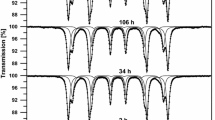Conclusions
-
1.
The melting of a metallic phase in contact with refractory compounds is due to low-melting-point eutectics, whose formation is caused by diffusion of the nonmetallic component of the refractory compound into the metal being investigated.
-
2.
In contact with the compounds studied, iron is more stable than nickel.
-
3.
Borides and suicides are the least stable compounds with respect to Ni and Fe, Fe-ZrB2 and Fe-WSi2 being the most stable pairs incorporating these compounds.
-
4.
In contact with Ni and Fe, carbides are more stable than borides or suicides. The greatest stability is exhibited by systems composed of Ni and carbides of the metals of group VI, and also the systems Fe-ZrC and Fe-WC.
-
5.
Nitrides and oxides are the most stable compounds with respect to the metals investigated.
Similar content being viewed by others
Literature cited
K. I. Portnoi, V. M. Romashov, et al., Poroshkovaya Met., No. 2, 15 (1967).
M. Hansen and K. P. Anderko, Constitution of Binary Alloys, McGraw-Hill, New York (1957).
Author information
Authors and Affiliations
Additional information
Translated from Poroshkovaya Metallurgiya, No. 1 (97), pp. 45–49, January, 1971.




